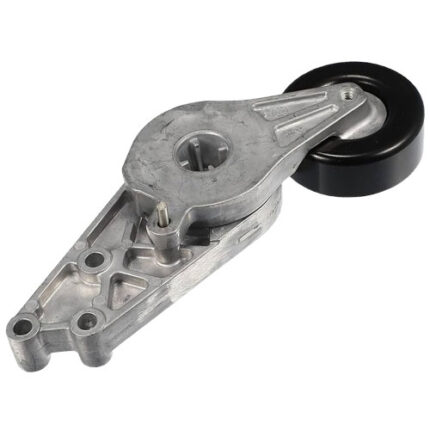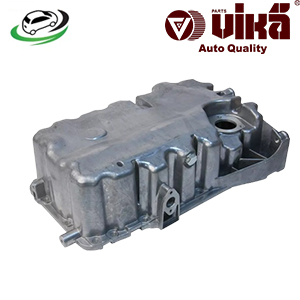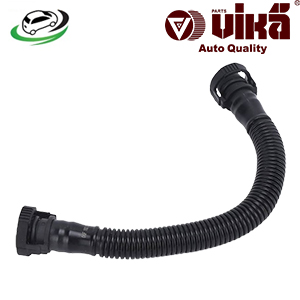Get Crankcase Vent Breather Hose Volkswagen Golf R 2.0T 06F103221E
The crankcase vent breather hose is an often overlooked but vital component of an engine’s ventilation system. Its primary role is to manage and recycle blow-by gases that escape from the engine’s combustion chamber, ensuring they don’t lead to excessive pressure buildup within the crankcase. This process not only enhances engine performance but also contributes to reducing emissions, thereby playing a critical role in the overall health and efficiency of a vehicle.
Understanding Blow-By Gases
To fully appreciate the importance of the crankcase vent breather hose, it’s essential to first understand what blow-by gases are and why they need to be managed. During the combustion process in an engine, a small amount of the combustion gases can escape past the piston rings and into the crankcase. These gases are referred to as blow-by gases, and they primarily consist of unburned fuel, carbon particles, and various hydrocarbons.
If these gases are allowed to accumulate within the crankcase, they can cause a number of issues. For one, the increased pressure can lead to oil leaks as seals and gaskets may be pushed beyond their designed limits. Additionally, the presence of blow-by gases in the crankcase can degrade engine oil, reducing its effectiveness and potentially leading to increased wear on engine components.
Benefits of a Crankcase Vent Breather Hose
1. Regulates Crankcase Pressure
- Prevents Pressure Buildup: The crankcase vent breather hose plays a vital role in regulating the pressure inside the engine’s crankcase. During the combustion process, gases can escape past the piston rings into the crankcase, leading to pressure buildup. The breather hose allows these gases to be safely vented, preventing potential damage to seals and gaskets.
- Reduces Oil Leaks: By maintaining optimal crankcase pressure, the breather hose helps prevent oil from being forced out through seals, which can lead to leaks and reduce engine efficiency.
2. Improves Engine Efficiency
- Recycles Blow-By Gases: The breather hose channels blow-by gases back into the engine’s intake system, where they are burned off during combustion. This recycling process improves overall fuel efficiency and ensures that the engine operates smoothly.
- Maintains Optimal Oil Performance: By preventing the accumulation of harmful gases in the crankcase, the breather hose helps maintain the quality of engine oil, ensuring it continues to lubricate and protect engine components effectively.
3. Reduces Harmful Emissions
- Minimizes Hydrocarbon Emissions: Blow-by gases contain unburned fuel and hydrocarbons that, if released into the atmosphere, contribute to air pollution. The crankcase vent breather hose ensures these gases are reintroduced into the combustion process, reducing the emission of harmful pollutants.
- Compliance with Emission Standards: Modern vehicles are subject to stringent emission regulations. The breather hose is a key component of the Positive Crankcase Ventilation (PCV) system, which helps vehicles meet these environmental standards by controlling the release of blow-by gases.
4. Enhances Engine Longevity
- Prevents Contamination: The breather hose helps keep the crankcase free from excessive blow-by gases, which can mix with engine oil and form sludge. This sludge can clog passages, reduce lubrication, and lead to increased wear on engine components. By venting these gases, the breather hose contributes to the longevity of the engine.
- Reduces Corrosion: Blow-by gases often contain moisture and acidic compounds that can corrode engine parts over time. The breather hose helps to expel these harmful substances, reducing the risk of internal corrosion.
5. Supports Proper Engine Operation
- Smooth Idling and Acceleration: A properly functioning breather hose ensures that the engine idles smoothly and accelerates without hesitation. When the hose is clogged or damaged, it can lead to rough idling, misfires, or poor acceleration due to improper air-fuel mixture.
- Maintains Vacuum Balance: The breather hose helps maintain the correct vacuum pressure within the engine, which is essential for the proper operation of various engine components, including the PCV valve.
6. Cost-Effective Maintenance
- Prevents Expensive Repairs: Regular maintenance and timely replacement of the crankcase vent breather hose can prevent more severe and costly engine problems, such as oil leaks, blown seals, and even engine failure. Since the breather hose is relatively inexpensive, it is a cost-effective way to protect your engine.
- Easy to Replace: The breather hose is typically easy to access and replace, making it a straightforward maintenance task for most vehicle owners. Regular inspection can help identify any signs of wear or damage before they lead to more significant issues.
7. Supports Aftermarket Upgrades
- Performance Enhancements: For those interested in performance upgrades, aftermarket breather hoses made from high-quality materials like silicone can offer improved durability and performance. These hoses can handle higher temperatures and pressures, making them ideal for high-performance or racing engines.
- Customization Options: Aftermarket breather hoses are available in various colors and styles, allowing enthusiasts to customize the look of their engine bay while also upgrading the functionality.
Signs of a Faulty Crankcase Vent Breather Hose
1. Oil Leaks
- Increased Pressure: If the crankcase vent breather hose is clogged or damaged, it can cause excessive pressure to build up inside the crankcase. This pressure may force oil past seals and gaskets, leading to noticeable leaks around the engine.
- Oil Spots: You might notice oil spots under your vehicle or see oil accumulating on the engine itself. This is a common sign that the breather hose is not functioning correctly.
2. Poor Engine Performance
- Rough Idling: A faulty breather hose can lead to improper air-fuel mixture, which may cause the engine to idle roughly or inconsistently. You might feel vibrations or hear the engine struggling to maintain a steady idle.
- Misfires: When the breather hose fails, it can result in engine misfires, particularly during acceleration. This is often due to unmetered air entering the engine, which disrupts the combustion process.
- Loss of Power: If the breather hose is clogged or leaking, the engine may struggle to perform efficiently, leading to a noticeable loss of power during acceleration or while driving uphill.
3. Decreased Fuel Efficiency
- Increased Fuel Consumption: A faulty crankcase vent breather hose can cause the engine to burn more fuel than usual. This is often a result of an improper air-fuel mixture caused by air leaks or blockages in the ventilation system.
- Frequent Refueling: If you find yourself refueling more often without a clear explanation, a failing breather hose could be contributing to the problem.
4. Check Engine Light
- Triggered Sensors: Modern vehicles are equipped with sensors that monitor various engine parameters, including the performance of the PCV system. A faulty breather hose can trigger the check engine light if the sensors detect issues like incorrect air-fuel ratios, misfires, or excessive crankcase pressure.
- Diagnostic Codes: When the check engine light comes on, a diagnostic scan may reveal codes related to the PCV system or air intake, indicating that the breather hose could be the culprit.
5. Oil Contamination
- Sludge Buildup: If the breather hose is clogged, blow-by gases may not be properly vented, leading to the accumulation of sludge in the engine oil. This sludge can be seen as a thick, dark deposit when inspecting the oil or oil cap.
- Degraded Oil Quality: Contaminated oil loses its effectiveness as a lubricant, which can lead to increased wear on engine components and potential overheating.
6. Unusual Engine Noises
- Whistling or Hissing: A cracked or disconnected breather hose can cause a whistling or hissing noise as air escapes from the system. This noise is often most noticeable when the engine is idling or under light acceleration.
- Popping Sounds: In some cases, a faulty breather hose can cause popping noises in the intake or exhaust system, particularly if the air-fuel mixture is significantly disrupted.
7. Excessive Smoke from the Exhaust
- Blue or White Smoke: If the breather hose is blocked or malfunctioning, it can cause oil to be drawn into the combustion chamber, leading to blue or white smoke being emitted from the exhaust. This smoke is a clear sign that oil is being burned along with the fuel.
8. Strong Odor of Oil or Fuel
- Burning Smell: A faulty breather hose can allow oil to escape onto hot engine components, where it can burn and produce a strong, unpleasant odor. You might notice this smell inside or outside the vehicle, especially after driving.
- Fuel Smell: If the breather hose is not properly venting blow-by gases, you might also detect a strong smell of fuel, indicating that unburned hydrocarbons are escaping from the engine.
9. Visible Damage to the Hose
- Cracks and Splits: Physical inspection of the breather hose may reveal visible cracks, splits, or other forms of damage. A hose that is brittle, swollen, or covered in oil residue is likely failing and needs to be replaced.
- Loose Connections: The hose may also become loose at its connection points, which can lead to leaks and improper ventilation.
Follow us on Facebook for more parts.



